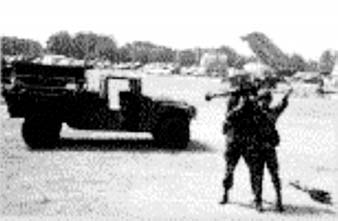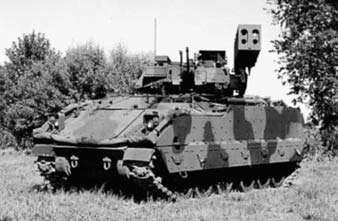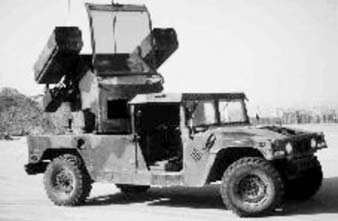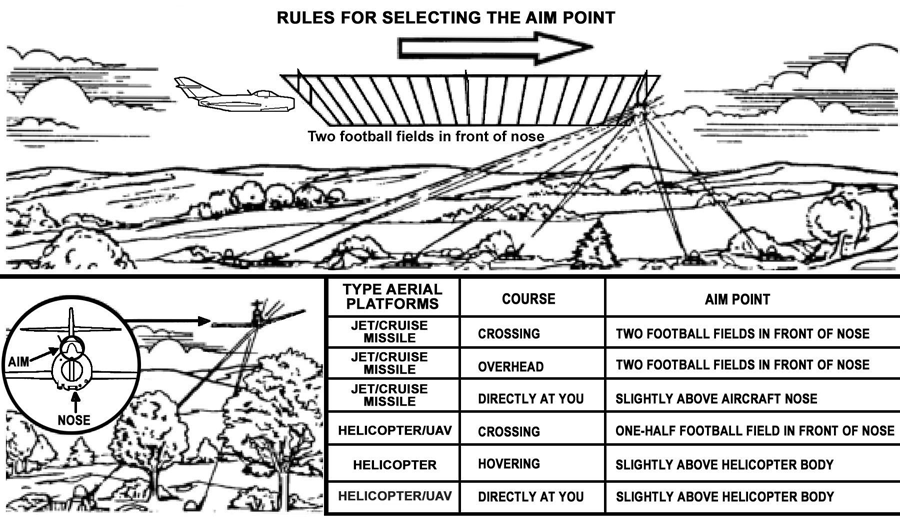SCATMINE systems is approximately 640 meters. However, the acceptable risk distance is 235 meters from the outer edges of the minefield's safety zone for troops in the open (Table 10-14, page 10-42).
10-41
FM 3-21.11
System
Safety Zone
Fragment Hazard Zone
ADAM/RAAM
500 to 1,500 meters from aim
235 meters from the outside
point(s) (depends on delivery
dimensions of the safety zone
method)
Gator
925 x 475 meters from aim point(s)
1,395 x 945 meters from aim point(s)
Ground Volcano
1,150 x 160 meters
235 meters from start and stop
points and the center line
Air Volcano
1,915 x 200 meters
235 meters from start and stop
points and the center line
MOPMS
See FM 20-32, Figures 3-15 through
235 meters from the outside
3-17, for specific placement.
dimensions of the safety zone
Table 10-14. Safety and fragment hazard zones.
10-26. SURVIVABILITY
Survivability operations protect the force. The SBCT infantry company commander plans, prioritizes, and enforces the survivability effort. The plan should specify the following:
• Level of survivability for each sub-unit position.
• Priority of survivability support by specific unit, type of weapon system, or combination.
• Type of position to be dug for a unit or type of system.
• Sequence and time allocated for platoons to receive blade support.
Additional considerations for survivability planning include command and control of digging assets, site security, CSS (fuel, maintenance, and Class I), and movement times between BPs. The commander should start the survivability effort as soon as practical.
He may employ blade assets to support systems such as mortars, C2, and key weapons before the bulk of his combat systems are ready for survivability support. The commander should establish a NLT time or a directed time to be ready for survivability.
This helps prevent waste of blade time. Companies prepare their area for the arrival of the blades by marking vehicle positions, identifying leaders to supervise position construction, and designating guides for the blade movement between positions.
Section IV. AIR DEFENSE ARTILLERY
The air defense and aviation coordination cell's (ADACC's) air and missile defense (AMD) analysis determines if the SBCT will be task-organized with air defense assets from a divisional short-range air defense (SHORAD) battalion. Even if the SBCT, and, subsequently the SBCT infantry battalion, receives air defense assets, it is unlikely that the SBCT infantry company will be task-organized with any of the air defense assets.
However, Avengers and Linebackers may operate in and around the company AO in support of battalion and brigade assets. Therefore, the company must conduct its own air defense operations, relying on disciplined passive air defense measures and the ability to actively engage aerial platforms with organic weapons systems.
10-27. SYSTEMS, ORGANIZATION, AND CAPABILITIES
The systems that may operate in and adjacent to the company AO are the Avenger and Linebacker (Table 10-15). All systems can operate as man-portable air defense system 10-42



FM 3-21.11
(MANPADS) or Stinger teams. A maneuver battalion normally is task organized with an air defense platoon equipped with four Avengers or Bradley Linebacker firing units. The company may have an air defense section moving with it; however, this section normally remains part of the air defense platoon, responsible for providing DS, GS, or general support-reinforcing (GS-R) coverage to the battalion.
Man-Portable System
Personnel: 2-man crew
Basic load: 6 missiles basic load
w/ M998 HMMWV
Acquisition/range: Visual
Engagement range: 5 km
Engagement altitude: 3 km +
Mutual support: 2 km +
Bradley Linebacker
Personnel: 4-man crew
Basic load: 10 missiles (4 ready to fire,
6 stowed)
Acquisition/range: Visual/thermal
Engagement range: 5 km (Stinger),
2500 m 25-mm, 900 m coax
Engagement altitude: 3 km +
Mutual support: 3 km
Emplacement time: Fire on the move
Reload time: 4 minutes
Avenger
Personnel: 2 man crew
Basic load: 8 ready-to-fire missiles,
250 rds .50 cal
Acquisition/range: Visual/FLIR 9-10 km,
laser range finder
Engagement range: 5 km +, .50 cal
range: 6,470 m
Rate of fire: 1025 rpmEngagement altitude: 3 km
+
Mutual support: 3 km
Emplacement time: 6 minutes,
can remote operations out to 50 meters
Table 10-15. Air defense systems.
10-28. EMPLOYMENT OF AIR DEFENSE SYSTEMS
In offensive situations, Avenger and Bradley Linebacker units accompany the main attack. They may maneuver with the battalion’s lead companies, orienting on low-altitude air avenues of approach. When the unit is moving or in a situation that entails short halts, the Bradley’s primary weapon is the 25-mm chain gun, which has an effective range of 2,000 meters. Consequently, to assure mutual support, Linebackers maneuver no farther than 1,000 meters away from other company elements. The Stinger gunners can dismount to provide air defense when the unit reaches the objective or pauses during the attack. In
10-43
FM 3-21.11
the defense, Avenger Bradley Linebacker units establish BPs based on available IPB
information and the company commander’s scheme of maneuver. Squads are positioned approximately 2 kilometers apart to maximize the air defense vehicles’ defensive capabilities. Avengers and Linebackers are often used to protect counterattacking maneuver units that are vulnerable to detection and attack by enemy air forces.
10-29. WEAPONS CONTROL STATUS
The weapons control status (WCS) describes the relative degree of control in effect for air defense fires. It applies to all weapons systems. The weapons control status is dictated in the battalion OPORD and may be updated based on the situation. The three levels of control are--
a. Weapons Free. Crews can fire at any air target not positively identified as friendly. This is the least restrictive weapons control status level.
b. Weapons Tight. Crews can fire only at air targets positively identified as hostile according to the prevailing hostile criteria.
c. Weapons Hold. Crews are prohibited from firing except in self-defense or in response to a formal order. This is the most restrictive control status level.
10-30. EARLY WARNING PROCEDURES
Air defense warnings (ADWs) include--
• RED - Air or missile attack imminent or in progress.
• YELLOW - Air or missile attack probable.
• WHITE - Air or missile attack not likely.
While air defense warnings cover the probability of hostile air action over the entire theater of war or operations, local air defense warnings describe with certainty the air threat for a specific part of the battlefield. Air defense units use these local warnings to alert Army units to the state of the air threat in terms of "right here, right now." There are three local air defense warning levels:
• DYNAMITE - Air platforms are inbound or are attacking locally now.
• LOOKOUT - Air platforms are in the area of interest but are not threatening.
They may be inbound, but there is time to react.
• SNOWMAN - No air platforms pose a threat at this time.
NOTE: The area air defense commander routinely issues air defense warnings for dissemination throughout the theater of war or operations. These warnings describe the general state of the probable air threat and apply to the entire area.
10-31. REACTION PROCEDURES
Reaction procedures include both passive and active air defense measures.
a. Passive Air Defense. Passive air defense consists of all measures taken to prevent the enemy from detecting or locating the unit, to minimize the target acquisition capability of enemy aircraft, and to limit damage to the unit if it comes under air attack.
One advantage the company can exploit is that target detection and acquisition are difficult for crews of high-performance aircraft. In most cases, enemy pilots must be able to see and identify a target before they can launch an attack.
10-44
FM 3-21.11
(1) Guidelines. The SBCT infantry company should follow these guidelines to avoid detection or limit damage:
• When stopped, occupy positions that offer cover and concealment; dig in and camouflage vehicles that are exposed. When moving, use covered and concealed routes.
• Disperse vehicles as much as possible to make detection and attack more difficult.
• Wipe out track marks leading to vehicle positions and eliminate or cover the spoil from dug-in positions.
• If moving when an enemy aircraft attacks, disperse and seek covered and concealed positions.
• Do not fire on a hostile fixed-wing aircraft unless it is clear that the aircraft has identified friendly elements. Premature engagement compromises friendly positions.
• Designate air guards for every vehicle and position; establish and maintain 360-degree security.
• Establish an air warning system in the unit SOP, including both visual and audible signals.
(2) Procedures. When the company observes fixed-wing aircraft, helicopters, or UAVs that could influence its mission, it initially takes passive air defense measures unless the situation requires immediate active measures. This reaction normally takes the form of each platoon’s React to Air Attack battle drill; however, the commander can initiate specific passive measures if necessary. Refer to the passive air defense guidelines for the company discussed earlier in this section.
NOTE: Passive air defense also includes the company’s preparations for conducting active air defense measures.
Passive air defense involves these three steps:
(a) Step 1 - Alert the company with a contact report.
(b) Step 2 - Deploy or take the appropriate actions. If the company is not in the direct path of an attacking aircraft, the commander or platoon leaders order vehicles to seek cover and concealment and halt with at least a 100-meter interval between vehicles. They also may be ordered to continue moving as part of the battalion.
(c) Step 3 - Prepare to engage. Fighting vehicle crews prepare to engage the aircraft with machine gun or main gun fire on order of the commander or their platoon leader.
b. Active Air Defense. If the commander determines that the SBCT infantry company is in the direct path of attacking aircraft, he initiates active air defense procedures, including React to Air Attack drills by the company’s platoons. Active air defense entails the following steps:
(1) Step 1 - Initiate fires. The primary intent is to force aircraft to take self-defense measures that alter their attack profile and reduce their effectiveness. Leaders may use a tracer burst to designate an aim point for machine gun antiaircraft fires (see Figure 10-13, page 10-46). Volume is the key to effectiveness; ICVs and MGSs throw up a "wall of steel" through which aircraft must fly. The MGS main gun and Javelin missiles are effective in company air defense employment against hovering attack helicopters; the
10-45

FM 3-21.11
MGS main gun and ICV M2s are effective against moving helicopters, and the tank main gun multipurpose antitank (MPAT) round is effective against high-performance aircraft.
(2) Step 2 - Create a nonlinear target. Vehicles move as fast as possible at a 45-degree angle away from the path of flight and toward attacking aircraft. Each platoon maintains an interval of at least 100 meters between vehicles, forcing aircraft to make several passes to engage the entire platoon.
(3) Step 3 - Move quickly to covered and concealed positions and stop. Vehicles freeze their movement for at least 60 seconds after the last flight of aircraft has passed.
(4) Step 4 - Send a spot report (SPOTREP). The company commander or XO updates the battalion commander on the situation as soon as possible.
Figure 10-13. Machine-gun aim points against helicopters and high-performance aircraft.
Section V. NBC SUPPORT
NBC assets within the SBCT are limited; therefore, it is imperative that the companies practice the fundamentals of NBC defense, avoidance, protection, and decontamination in order to survive on a contaminated battlefield.
10-32. RECONNAISSANCE SUPPORT
The NBC reconnaissance platoon organic to the RSTA squadron is the only internal NBC
reconnaissance available to the SBCT. The NBC reconnaissance platoon can locate, identify, and mark areas of contamination. Since NBC reconnaissance assets are limited, the SBCT infantry company commander must plan for alternate means of conducting NBC reconnaissance (such as scouts and MPs).
10-46
FM 3-21.11
10-33. DECONTAMINATION SUPPORT
External decontamination support is not available at the company level. For operational decontamination, the SBCT infantry company must request support from the SBCT
infantry battalion decontamination team, which is equipped with the modular decontamination system (MDS). Thorough decontamination operations require the support of an external decontamination platoon. The company must request this support through the SBCT infantry battalion and SBCT S3 sections. The contaminated company will be tasked to augment the decontamination platoon during the conduct of thorough decontamination operations. (For a more detailed discussion of decontamination requirements, refer to FM 3-5).
10-47
FM
3-21.11
CHAPTER 11
COMBAT SERVICE SUPPORT OPERATIONS
Simply stated, the role of combat service support in any military unit is to sustain the force for continuous combat operations. Within the SBCT, a brigade support battalion (BSB) will provide the distribution of supplies and services to company, troop, and battery level. Depending on METT-TC, volume of supplies, expected future operations, and current situation, that level of distribution may be to battalion, company/team, or platoon level. Generally, distribution to SBCT infantry battalions is provided to the company/team. Distribution to other SBCT units will be executed on an “area support” basis and normally will occur at the same time as the parent battalion under the current task organization of units. At the SBCT
infantry company level, the SBCT infantry company commander has ultimate responsibility for CSS. The executive officer and the first sergeant are the SBCT infantry company's primary CSS operators; they work closely with the SBCT battalion staff to ensure they receive the required support for the company's assigned operations.
Section I. CSS PLANNING CONSIDERATIONS
SBCT battalion and SBCT infantry company commanders, as well as the SBCT battalion S4, make plans and key decisions concerning CSS. The battalion S4, company executive officer, company first sergeant, company supply sergeant, platoon sergeants, and squad leaders implement these plans. Platoon leaders plan and make CSS decisions to accomplish their assigned missions according to guidance from higher headquarters and SOPs. Unit SOPs should address planning, implementation, and responsibilities in detail and should standardize as many routine CSS operations as possible.
11-1. GENERAL
GUIDELINES
In SBCT infantry battalions, the health service support assets are assigned to the battalion headquarters company. The battalion medical platoon provides HSS to the companies. The brigade support battalion provides each SBCT infantry company with key logistics support, such as equipment, supplies, and other support functions including petroleum, oils, and lubricants (POL) and transportation requirements. The respective battalion staff supports other CSS functions, such as personnel, legal, and religious (for example, the S1 and unit ministry team [UMT])).
a. Within this support structure, the SBCT infantry company must plan, prepare, and execute its portion of the SBCT battalion CSS plan. Concurrent with other operational planning, the company develops its CSS plan during mission analysis and refines it in the war gaming portion of the troop-leading process. CSS rehearsals are normally conducted at both SBCT battalion and company levels to ensure a smooth, continuous flow of materiel and services.
b. The company’s basic CSS responsibilities are to report and request support requirements through the correct SBCT battalion channels and to ensure that CSS operations are properly executed when support elements arrive in the company area. The XO and 1SG
are normally in charge of these functions, with guidance and oversight provided by the
11-1
FM 3-21.11
company commander. They must submit accurate personnel and logistical reports, along with other necessary information and requests.
11-2. COMPANY
RESPONSIBILITIES
The SBCT infantry company headquarters is responsible for the coordination and execution of CSS functions within the company. This includes reporting current status, requesting supplies or support, and conducting effective CSS operations within the unit. The primary CSS functions required by the SBCT infantry company include casualty evacuation, resupply operations, maintenance activities, and personnel service support. The following SBCT infantry company personnel have the primary responsibility for company CSS.
a. Commander. The commander ensures that CSS operations sustain his company's fighting potential. He integrates CSS activities into the tactical plan and provides guidance to the CSS operators. He tailors his CSS operations to meet the tactical plan.
b. Executive Officer. The XO coordinates and supervises the company's logistical effort. During the planning, he receives status reports from the platoon leaders, platoon sergeants, and 1SG; reviews the tactical plan with the company commander to determine company CSS requirements; and coordinates these needs with the battalion S4. During execution, the XO locates at the second most important place on the battlefield, as determined by the company commander. At times, this is the place from which he can best supervise sustainment operations. The XO also performs the following CSS functions:
• Determines the location of the company's resupply point based on data developed during operational planning and the war gaming process.
• Compiles periodic status reports from the platoon leaders, the PSGs, and the 1SG; provides updates to the commander as required.
• Along with the 1SG, ensures that the company executes CSS operations in accordance with the SBCT battalion plan and SOP.
• Ensures the CSS needs of supporting units are met.
c. First Sergeant. The company 1SG is a fighter first and logistician second. In addition to his tactical responsibilities listed in Chapter 1, the 1SG will be a key player in CSS operations for the company. He also is a key player in the execution of the company’s CSS plan and may supervise the company trains based upon commander intent and the factors of METT-TC. He ensures that the XO receives current status reports from all subordinate units, assists the XO in preparing reports and requests to battalion, and helps the XO or commander prepare paragraph 4 of the OPORD.
(1) The 1SG ensures receipt, consolidation, and forwarding of all logistics, personnel, and casualty reports to the battalion combat trains CP. He normally supervises the evacuation of casualties, EPWs, and damaged equipment. He normally supervises company resupply activities and monitors company maintenance activities.
(2) The 1SG orients new replacements and assigns them to squads and platoons IAW
the company commander's guidance.
(3) The 1SG ensures the required information is received from the platoon and section sergeants and the senior trauma specialist. These NCOs are responsible for providing all CSS reports IAW the SBCT infantry company SOP.
(4) The 1SG may also perform the following CSS functions:
11-2
FM
3-21.11
• Conduct CSS rehearsals at the company level and integrate CSS into the company's maneuver rehearsals.
• Normally direct and supervise the medical team and move it forward when the situation requires.
• Maintain the battle roster for the company.
d. Supply Sergeant. The supply sergeant is the company representative in the BSA.
(1) He verifies the logistics package (LOGPAC) and moves with the LOGPAC forward to the company. He assists with resupply and coordinates the company's CSS requirements with the BSB’s supply support platoon leader and the SBCT infantry battalion S4. The supply sergeant may control the medical evacuation vehicle when it is unable to remain forward with the company. He monitors the tactical situation and adjusts the CSS plan as appropriate to meet the tactical plan and the company commander's guidance. He may assist the commander by establishing caches. He forecasts the company's consumption of food, water, ammunition, POL, and batteries, based on the operation.
(2) The supply sergeant also performs the following CSS functions:
• Coordinates with the battalion S4 for resupply of Classes I, III, and V.
• Maintains individual supply and clothing records; requisitions Class II resupply as needed.
• Requests Class IV and Class VII equipment and supplies.
• Coordinates with the SBCT infantry battalion’s combat repair team (CRT) to turn in and pick up maintenance documents, routine Class IX supplies, and recoverable materials.
• Picks up replacement personnel and, as necessary, delivers them to the 1SG.
• Receives and evacuates human remains and personal effects to the mortuary affairs point in the BSA.
• Transports, guards, and transfers EPWs as required.
• Accompanies the LOGPAC to the logistics release point (LRP) and guides the LOGPAC to the company resupply point.
• Accompanies the LOGPAC along with EPWs and damaged vehicles (if applicable) back to the BSA.
• Coordinates with the SBCT battalion S1 section to turn in and pick up mail and personnel action documents.
• Collects hazardous material (HAZMAT) and transports it to collection points as part of LOGPAC procedures.
• Maintains and provides supplies for company field sanitation activities.
e. Platoon Sergeant. Each PSG in the company performs the following CSS
functions:
• Ensures crews perform proper maintenance on all assigned equipment.
• Compiles and submits all personnel and logistics status reports for the platoon as directed or in accordance with SOP.
• Collects each equipment inspection and maintenance form (DA Form 2404 or 5988) within the platoon.
• Obtains supplies and equipment (all classes except Class VIII) and mail from the supply sergeant and ensures proper distribution within the platoon.
f. Senior Trauma Specialist/Senior Company Medic. The senior trauma
11-3
FM 3-21.11
specialist/senior company medic is attached to the rifle company to provide emergency medical treatment for sick, injured, or wounded company personnel. Emergency medical treatment procedures performed by the trauma specialist may include opening an airway, starting intravenous fluids, controlling hemorrhage, preventing or treating for shock, splinting fractures or suspected fractures, and providing relief for pain. The EMT
performed by the trauma specialist is under the supervision of the







